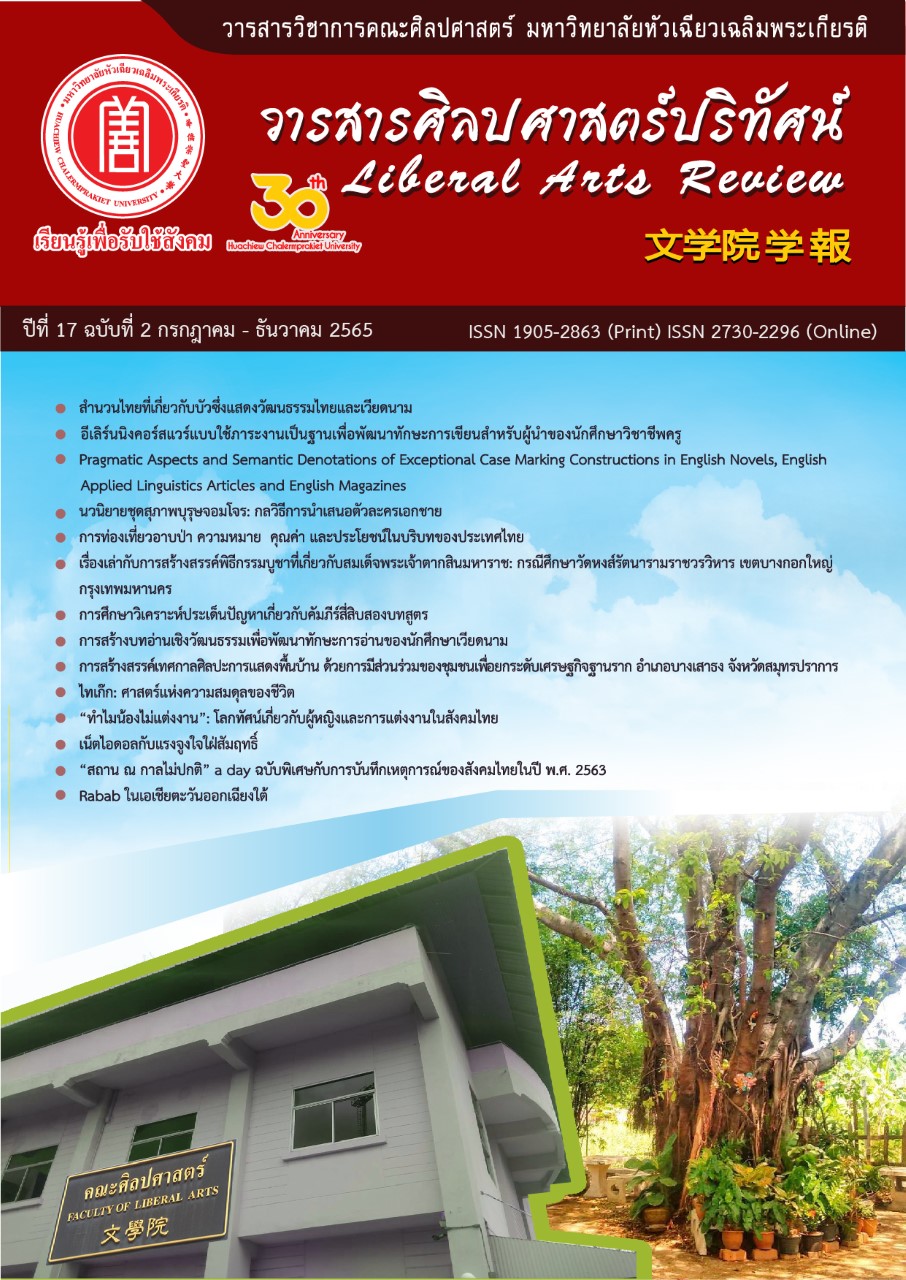Rabab in Southeast Asia
DOI:
https://doi.org/10.14456/lar.2022.24Keywords:
Rabab, Southeast Asia, SpreadingAbstract
The study of Rabab in Southeast Asia aimed to study the background and spreading of Rabab. Rabab was a type of musical instrument widely performed throughout Western Asia, Central Asia, South Asia, and Southeast Asia. Rabab was characterized by a wide variety. It might have originated in Afghanistan (Kasnawiya Empire centered on Ghazni where is located in present-day Afghanistan) that appears in northwestern India and it was accepted around the mid-18th century. Rabab has arrived in Hindustani music as a Sarod. In Afghanistan, rabab was the dominant instrument in the region as well as Pakistan and Kashmir. In Southeast Asia, there was evidence that the lute is similar to the Indian Rabab originated in a near era. That is, during the Moriya and Gupta dynasties, there was a period of movement in politics, administration, trade, and religion, thus causing the spreading of art and culture found in Thailand, Vietnam and Indonesia. There was evidence of a stucco sculpture depicting musicians playing the lutes in the central region at the ancient city of Khu Bua, Ratchaburi, in Thailand, at the Cham Museum in Vietnam and at the stupa of Borobudur Temple in Indonesia.
References
กรมการศาสนา. (2558). ศาสนาในประเทศไทย. กรุงเทพมหานคร: รุ่งศิลป์การพิมพ์.
กำจร สุนพงษ์ศรี. (2558). ประวัติศาสตร์ศิลปะอินเดีย (พิมพ์ครั้งที่ 2). กรุงเทพมหานคร: โรงพิมพ์แห่งจุฬาลงกรณ์มหาวิทยาลัย.
เฉลิมศักดิ์ พิกุลศรี. (2535). วัฒนธรรมอินเดียในดนตรีไทยและเอเชียตะวันออกเฉียงใต้. ในมหาวิทยาลัยขอนแก่น ปฏิสัมพันธ์ทางวัฒนธรรมดนตรีไทยและเอเชียตะวันออกเฉียงใต้: ดนตรีไทยอุดมศึกษา ครั้งที่ 23. มหาวิทยาลัยขอนแก่น.
เฉลิมศักดิ์ พิกุลศรี. (2548). ดนตรีอินเดีย. กรุงเทพมหานคร: แอคทีฟ พริ้นท์ จำกัด.
ฮอลล์ ดี.จี.อี. (2526). ประวัติศาสตร์เอเชียตะวันออกเฉียงใต้ เล่ม 1 [A History of South-East Asia] (วรุณยุพา สนิทวงศ์ ณ อยุธยา และคณะ, แปล). กรุงเทพมหานคร: ไทยวัฒนาพานิช.
ธนิต อยู่โพธิ์. (2498). ดนตรีในพระธรรมวินัย. กรุงเทพมหานคร: โรงพิมพ์พระจันทร์.
พูนพิศ อมาตกุล. (2535). ภาพรวมของดนตรีในกลุ่มประเทศเอเชียอาคเนย์. ในมหาวิทยาลัยขอนแก่น ปฏิสัมพันธ์ทางวัฒนธรรมดนตรีไทยและเอเชียตะวันออกเฉียงใต้: ดนตรีไทยอุดมศึกษา ครั้งที่ 23. มหาวิทยาลัยขอนแก่น.
เมชฌ สอดส่องกฤษ. (2554). ดนตรีจีนและเพลงจีน. อุบลราชธานี: โรงพิมพ์มหาวิทยาลัยอุบลราชธานี.
วัลภา ขวัญยืน พัชรินทร์ ศุขประมูล และ แสงจันทร์ ไตรเกษม (ผู้เรียบเรียง). (2535). ดุริยางค์ผสานศิลป์. กรุงเทพมหานคร: อมรินทร์พริ้นติ้งกรุ๊พ.
สุจิตต์ วงษ์เทศ. (2549). สุวรรณภูมิต้นกระแสประวัติศาสตร์ไทย. กรุงเทพมหานคร: มติชน.
สุภัทรดิศ ดิสกุล, หม่อมเจ้า. (2553). ประวัติศาสตร์เวียดนาม (พิมพ์ครั้งที่ 6). นนทบุรี: มติชนปากเกร็ด.
เหรียญกษาปณ์เเละเงินตราโบราณ.(2555). เงินอาณาจักรทวารวดี (พุทธศตวรรษที่ 12-16). ค้นคืนจาก http://skyline2526.blogspot.com/2012/12/12-16.html.
อมรา ศรีสุชาติ (ผู้เรียบเรียง). (2557). ศรีวิชัยในสุวรรณทวีป. กรุงเทพมหานคร: รุ่งศิลป์การพิมพ์.
อาณัติ อนันตภาค. (2558). ประวัติศาสตร์เวียดนาม. กรุงเทพมหานคร: วิชั่น พรีเพรส.
Miner, A. (1997). Sitar and Sarod in the 18th and 19th Centuries. Delhi: St. Motil Banarsidass Publishers Private Limited.
Morton, D. (1976). The Traditional Music of Thailand. Oakland, CA: University of California Press.
Tamori, M. (2008). The Transformation of Sarod Gharana: Transmitting Musical Property in Hindustani Music. SENRI ETHNOLOGICAL STUDIES, 71, 169-202. Doi: 10.15021/00002617
Trần Kỳ Phương, Võ Văn Thắng and Peter D. Sharrock. (2018). Vibrancy in Stone: Masterpieces of the Danang Museum of Cham Sculpture. 1st ed. Thailand. Sirivatana Interprint Public Co., Ltd.
Tripadvisor. Ajanta, india. [Image on internet]. (2017). [updated 2017 April; cited 2022 October 14]. Retrieved from https://shorturl.asia/5LcQj.
Unesco. Exploring Borobudur World Heritage Site through Music [Internet]. (2021). [updated 2021 July 5; cited 2021 September 2]. Retrieved from https://bit.ly/32TcbcD.
Downloads
Published
How to Cite
Issue
Section
License
Copyright (c) 2022 Liberal Arts Review

This work is licensed under a Creative Commons Attribution-NonCommercial-NoDerivatives 4.0 International License.
บทความที่ได้รับการตีพิมพ์เป็นลิขสิทธิ์ของวารสารศิลปศาสตร์วิชาการและวิจัย
ข้อความที่ปรากฏในบทความแต่ละเรื่องในวารสารวิชาการเล่มนี้เป็นความคิดเห็นส่วนตัวของผู้เขียนแต่ละท่านไม่เกี่ยวข้องกับมหาวิทยาลัยหัวเฉียวเฉลิมพระเกียรติ และคณาจารย์ท่านอื่นๆ ในมหาวิทยาลัยฯ แต่อย่างใด ความรับผิดชอบองค์ประกอบทั้งหมดของบทความแต่ละเรื่องเป็นของผู้เขียนแต่ละท่าน หากมีความผิดพลาดใดๆ ผู้เขียนแต่ละท่านจะรับผิดชอบบทความของตนเองแต่ผู้เดียว




